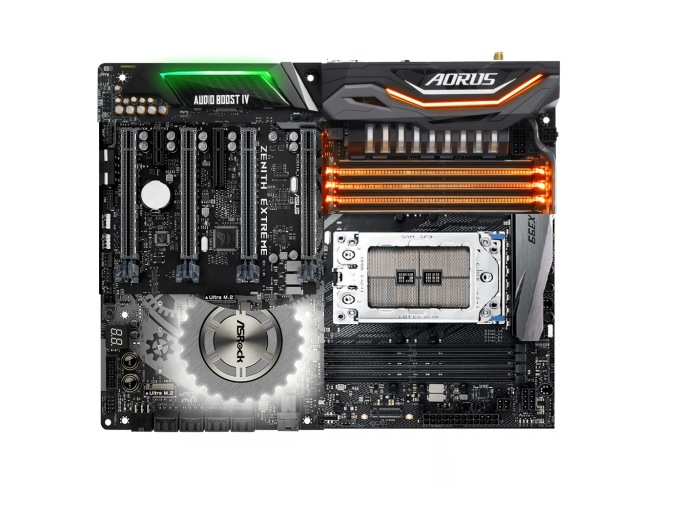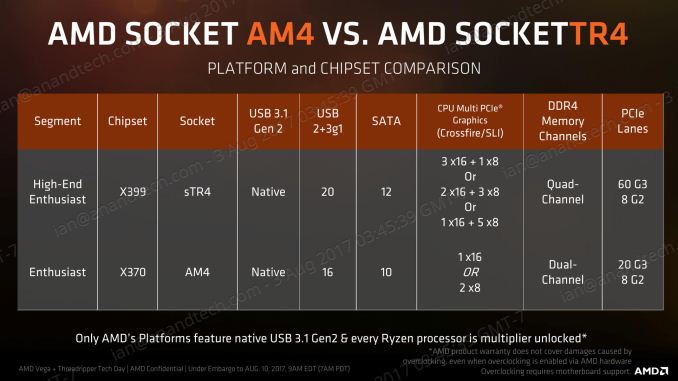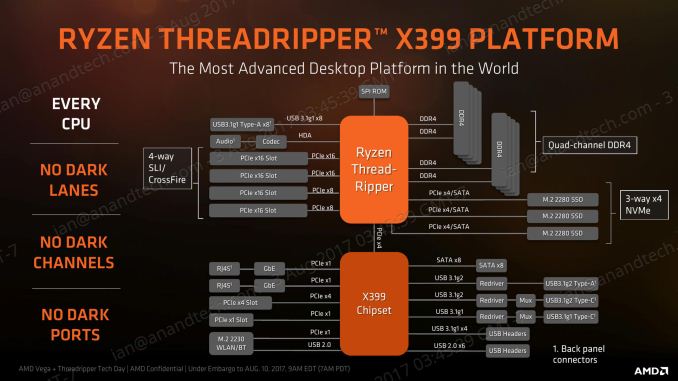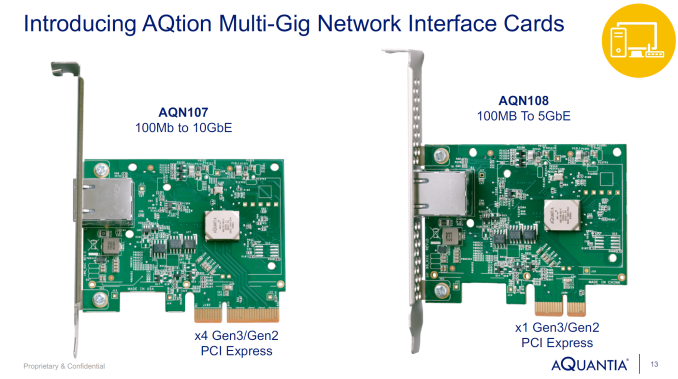An AMD Threadripper X399 Motherboard Overview: A Quick Look at Seven Products
by Ian Cutress & Joe Shields on September 15, 2017 9:00 AM EST
With the release of AMD’s Threadripper CPUs into the HEDT market, board partners have released new motherboards based on the X399 chipset. Consumers are going to see quad channel memory, native 4-Way SLI and Crossfire capabilities, more full-speed M.2 slots, added 10G network ports, and more on the new platform. We're taking a quick look at each of the motherboards that the vendors are promoting in the market, as well as a few upcoming teasers.
Related Reading
- The AMD Ryzen Threadripper 1950X and 1920X Review: CPUs on Steroids
- AMD Threadripper Unboxing
- AMD Threadripper 1920X and 1950X CPU Details: 12/16 Cores, 4 GHz Turbo, $799 and $999
- AMD CPU Updates: 16 Core Threadripper w/64 PCIe Lanes This Summer, Epyc Launching June 20th
AMD Ryzen Threadripper Needs a Mother(board)
A big takeaway from our AMD Ryzen Threadripper 1950X and 1950X review is the increase in CPU connected PCIe 3.0 lanes. A full 60 lanes are available to the PCIe slots and M.2 drives, while 4 lanes head off to the chipset where it's muxed for USB, SATA, low-level I/O, and other features. The increase in CPU PCIe lanes is set up to allow for a lot more flexibility connecting devices using PCIe bandwidth.
The four major players, ASRock, ASUS, GIGABYTE, and MSI, have launched X399 motherboards for Threadripper. These boards equip the massive 4094-pin socket with eight DIMM slots to cover the four memory channels and then differentiate themselves in PCIe configuration, IO, styling and software support.
Unlike Ryzen, the base processor is not a true SoC as the term has evolved over the years. In order to get the compliment of SATA and USB ports, each Threadripper CPU needs to be paired with an X399 chipset. So aside from the CPU PCIe lanes, the 'new' X399 chipset also gets some IO to play with:
Unlike mainstream platforms that have several chipsets to choose from that vary in capability and cost, the AMD high-end platform only has a single chipset, similar to Intel's X299. As we've learned over the last few months, some elements of the motherboard base cost, such as the socket, can cost a pretty penny to the board manufacturers, which in turn will be forwarded on to the user. These motherboards appear to start somewhere around $249-$299, with the top board so far set at $549. Guess which one AMD sent us for our CPU review.
The Underlying Block Diagram
When PCIe is the game, it becomes time to play with controllers and ports to see what fits. It all starts with the underlying diagram for Threadripper and X399:
AMD's marketing on the left is set out to explain that each product in the Threadripper and X399 line will be 'fully enabled' - none of the chips will be limited in PCIe lane counts or DRAM for the sake of segmentation. AMD is happy at this point to keep segmentation limited to cores, frequency, and L3 cache.
The diagram shows the two hubs for everything to connect to: the CPU and the chipset. The CPU has 60 PCIe lanes, provided in 3 or 4 PCIe root complexes at x16 each (the diagram above suggests x16/x8/x16/x8). These will often go towards the main PCIe slots to support add-in cards like GPUs, or they could be partitioned off for RAID controllers or fast ethernet if required. In total, AMD has stated that the platform can support six GPUs maximum. The CPU also supports eight USB 3.1 (5 Gbps) Type-A ports, quad channel DDR4, and support for up to three PCIe 3.0 x4 storage drives for 3-way NVMe.
Threadripper CPUs reserve four PCIe lanes for the chipset, which similar to Intel acts like a PCIe switch for more IO - although AMD only offers a few lanes here compared to Intel's 24 PCIe 3.0 x4 lanes.
From the chipset there are eight PCIe lanes, which AMD here has suggested reserving two for gigabit Ethernet, four for a PCIe x4 slot, one for a PCIe x1 slot, and one for a WiFi module. Alongside the PCIe lanes are eight SATA ports, six USB 2.0 ports, four USB 3.1 (5 Gbps) Type-A ports, one USB 3.1 (5 Gbps) Type-C port and two USB 3.1 (10 Gbps) ports with appropriate redrivers. In a change to what we normally see on Intel motherboards, AMD lists SPI and Audio features as coming from the CPU rather than the chipset.
AMD Suggests Variants
As part of the launch, AMD is wanting to promote the different ways in which an X399 motherboard could be arranged depending on the workload requirements.
| X399 Potential Configurations | |||
| Use | PCIe Lanes | Total | |
| Content Creator | 2 x Pro GPUs 2 x M.2 Cache Drives 10G Ethernet 1 x U.2 Storage 1 x M.2 OS/Apps 6 x SATA Local Backup |
x16/x16 from CPU x4 + x4 from CPU x4 from CPU x4 from CPU x4 from CPU From Chipset |
52 Lanes |
| Extreme PC | 2 x Gaming GPUs 1 x HDMI Capture Card 2 x M.2 for Games/Stream 10G Ethernet 1 x M.2 OS/Apps 6 x SATA Local Backup |
x16/x16 from CPU x8 from CPU x4 + x4 from CPU x4 from CPU x4 from CPU From Chipset |
56 Lanes |
| Streamer | 1 x Gaming GPU 1 x HDMI Capture Card 2 x M.2 Stream/Transcode 10G Ethernet 1 x U.2 Storage 1 x M.2 OS/Apps 6 x SATA Local Backup |
x16 from CPU x4 from CPU x4 + x4 from CPU x4 from CPU x4 from CPU x4 from CPU From Chipset |
40 Lanes |
| Render Farm | 4 x Vega FE Pro GPUs 2 x M.2 Cache Drives 1 x M.2 OS/Apps 6 x SATA Local Backup |
x16/x8/x8/x8 x4 + x4 from CPU x4 from CPU From Chipset |
52 Lanes |
Each of these potential configurations would run into several thousand dollars a piece for a full build - the M.2 drives were suggested at 512GB minimum, with the SATA drives in RAID configurations as well. AMD is making no joke; they want to be the premium platform.
New Controllers for X399
With each of these motherboard overviews, we like to cover a few of the newer controllers to hit the market that motherboard manufacturers might take advantage of. Given the recent X299 launch on the Intel side, not much has changed since. The big parts to enter the consumer space are Aquantia's multi-gigabit ethernet controllers.
Aquantia launched two ethernet controllers: the AQC107 which supports 100MB, 1G, 2.5G, 5G and 10G, and the AQC108 which supports 100MB, 1G, 2.5G and 5G, all through standard RJ45 connectors. Motherboard manufacturers can use these controllers directly on the boards, or bundle them in add-in cards like the AQN107 and AQN108 above. We've seen cards from ASUS and GIGABYTE already hit the market based on these controllers, while ASRock and MSI prefer to integrate them direct.
The second controller worth mentioning is the updated ASMedia ASM3142 controller, providing USB 3.1 Gen 2 (10 Gbps) functionality to motherboards that need more USB 3.1g2. Originally we saw the ASM1142 single lane controller, while the ASM2142 integrated a dual lane design such that all the ports had peak bandwidth when multiple ports are in use. ASM3142 is a low powered version of the ASM2142, but still supporting all the ports at peak bandwidth.
Third is the updated Realtek ALC1150 audio codec, known as the ALC1220. The ALC1220 improves peak SNR while adding new functionality. ASUS run a customized version known as the ALC1220A, which removes some of the excess function for a stripped down version unique to them but configured in a partnership with Realtek.
The Motherboards
The seven motherboards we have to discuss are:
- The ASRock X399 Taichi
- The ASRock X399 Professional Gaming
- The ASUS X399 ROG Zenith Extreme
- The ASUS Prime X399-A
- The ASUS Strix X399-E Gaming
- The GIGABYTE X399-Gaming 7
- The MSI X399 Gaming Pro Carbon
- The MSI X399 SLI Plus
Added on 9/19: The GIGABYTE X399 Designare EX
Added on 10/10: The MSI X399 SLI Plus




















99 Comments
View All Comments
LordanSS - Saturday, September 16, 2017 - link
My money is on the latter.... =/vgray35@hotmail.com - Friday, September 15, 2017 - link
With CPU power approaching 150 Amps, all these MBs are brain dead right out the gate, for using 50y old 8+ phase Buck converter topology, where VRMs with multiple phases still have poor response settling times (not one cycle settling but 20 cycles), lowish efficiencies way below 98% needing substantial heat sinks; while being saddled with the vagaries of inductive energy storage which takes up a lot of space and cost much more. Instead they should be using hybrid-PWM switching eliminating hard switch of high currents, where fractional cycle resonance ensures zero current switching and almost no switching losses. Resonance frequency scaling of the inductor/capacitor eliminates the need for ferrite cores altogether, reducing both size and core losses.http://www.powerelectronics.com/power-management/s...
Rehashing the same old power technologies with only stepwise minuscule improvements at each iteration, is not going to bode well at all. These engineers need to join the rest of us in the 21st century, and stop rehashing inductive energy storage solutions in power supplies. These new power topologies have been available for 5y to 8y now. And further this will also reduce EMI noise.
vgray35@hotmail.com - Friday, September 15, 2017 - link
I might add eliminating the multi-phase Buck converters for a solution based on PWM-resonance switching (hybrid switching), fractional cycle resonance (one cycle settling responses), and resonance scaling of resonance components, will likely permit a X399 mITX board to be made; with all that PSU space recovered for other purposes. Who will take up the challenge? AMD, ASROCK? Or will Intel beat AMD in the rush to high current capability at 99% efficiency? Or one of the other competitors out there! A clarion call to action this is to once and for all retire the Buck converter!ddriver - Friday, September 15, 2017 - link
I doubt they will even make a micro atx board, much less itx...It will be a waste, gigantic socket will take up most of the space, there won't be enough room for all 4 memory channels, the CPUs generous amount of PCIE lanes will be utterly wasted.
vgray35@hotmail.com - Friday, September 15, 2017 - link
Yes, and yet ASROCK put the X99 on a mITX board. However cutting heat from the VRM's by 60% to 70% or more should be done anyway, not to mention the graphics cards that draw even more power. Why settle for 95/96% efficiency (or worse in some cases) when one could get 98.5% to 99% efficiency. But then again you might be right concerning Thread Ripper, although I would still buy it with M2 slots on the back. The power delivery could be moved entirely to the back of the board without heat sinks with a total height of only 1.5mm (possibly at the center of socket itself on the back). The challenge of course is just as applicable to the graphics cards.ddriver - Saturday, September 16, 2017 - link
Hm, it seems that they launched some lga2066 boards recently, an asrock itx and an msi matx. TR4 however is still atx and up only...DanNeely - Friday, September 15, 2017 - link
I agree about how little sense it would make; but there have been a few LGA2011 mITX boards for people who only needed the higher core count. One of the two currently listed on Newegg uses SoDIMMs and riser boards around the CPU socket to make everything fit. Doing it for Threadripper would definitely be harder on account of the bigger socket; but I won't say never.Xajel - Saturday, September 16, 2017 - link
mITX is very hard even with riser boards & only 4x SO-DIMMsbut mATX on the other hand is very plausible... lets hope for a mATX version of the ASRock Pro Gaming with it's 10GbE ( and at least one of it's Intel's 1GbE ), at least 2 of it's M.2's and 6+ SATA ports... and please ASRock, add a front USB 3.1g2 header...
ddriver - Friday, September 15, 2017 - link
Amps, or amperes, is a unit of current, not a unit of power. Power is measured in watts."Rehashing the same old power technologies with only stepwise minuscule improvements at each iteration, is not going to bode well at all." - this is unfortunately a fact, and the de-fact motto of the industry.
ddriver - Friday, September 15, 2017 - link
I mean it is kinda naive to assume several years old switching circuits will find their way into the mainstream just because they are a few percent better.We've had gas turbine engines for decades, but they are still only used in tanks, helicopters or naval ships, while mainstream vehicles are still stuck with the internal combustion engine, which is easier to break, harder to maintain and a whooping 60% less efficient.